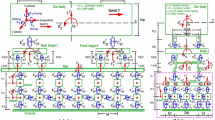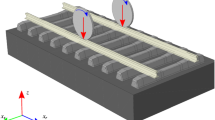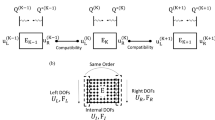Abstract
The safety of a passing train depends on different factors, of which one of the most important is the behavior of the foundation. Therefore, the effects of the nonlinearity of ballast on the dynamic responses of the railway track are a key research interest. In this paper, a new model of railway sleepers posed on a nonlinear foundation has been developed. By coupling the finite element method (FEM) of the sleeper with an analytical model of the periodically supported beam model, the dynamic equation of the sleeper is developed. On the other hand, by considering a periodic series of moving loads, this equation can be transformed to a forced nonlinear oscillation. Iteration procedures have been built to calculate the periodic solution. This method has demonstrated a good convergence of results by comparison with the analytical solution in the linear case. The influence of the nonlinear foundation has been investigated by two examples: cubic-nonlinear and bi-linear foundations. The parametric studies demonstrate that numerical results converge with a small number of iterations.











Similar content being viewed by others
Data Availability
Data sharing not applicable to this article as no datasets were generated or analyzed during the current study.
References
Kriloff, A.: Uber die erzwungenen schwingungen von gleichformigen elastischen staben. Math. Ann. 61(2), 211–234 (1905)
Timoshenko, S.: Uber die erzwungenen schwingungen von gleichformigen elastischen staben. Z. Angew. Math. Phys. 59(2), 162–203 (1911)
Frýba, L.: Vibration of Solids and Structures under Moving Loads. Springer, Dordrecht, Czech (1972)
Timoshenko, S., Young, D., Weaver, W.: Vibration Problems in Engineering. Wiley & Son, (1991)
Wang, T.M., Stephens, J.E.: Natural frequencies of timoshenko beams on pasternak foundations. J. Sound Vib. 51(2), 149–155 (1977)
Adams, G.G.: Critical speeds and the response of a tensioned beam on an elastic foundation to repetitive moving loads. Int. J. Mech. Sci. 37(7), 773–781 (1995)
Ichikawa, M., Miyakawa, Y., Matsuda, A.: Vibration analysis of the continuous beam subjected to moving mass. J. Sound Vib. 230(3), 493–506 (2000)
Sun, L.: A closed-form solution of a bernoulli-euler beam on a viscoelastic foundation under harmonic line loads. J. Sound Vib. 242(4), 619–627 (2001)
Chen, Y.-H., Huang, Y.-H.: Dynamic characteristics of infinite and finite railways to moving loads. J. Eng. Mech., 129, 987–995, 09 (2003)
Mallik, A.K., Chandra, Sarvesh, Singh, Avinash B.: Steady-state response of an elastically supported infinite beam to a moving load. J. Sound Vib. 291(3), 1148–1169 (2006)
Faruk Fırat Çalım: Dynamic analysis of beams on viscoelastic foundation. Eur. J. Mech. A. Solids 28(3), 469–476 (2009)
Varandas, José N., Hölscher, Paul, Silva, Manuel A.G..: Dynamic behaviour of railway tracks on transitions zones. Comput. Struct. 89(13), 1468–1479 (2011)
Mead, D.J.: Free wave propagation in periodically supported, infinite beams. J. Sound Vib. 11(2), 181–197 (1970)
Mead, D.J.: A new method of analyzing wave propagation in periodic structures; applications to periodic timoshenko beams and stiffened plates. J. Sound Vib. 104(1), 9–27 (1986)
Mead, D.J.: The response of infinite periodic beams to point harmonic forces: a flexural wave analysis. J. Sound Vib. 144(3), 507–529 (1991)
Mead, D.J.: Wave propagation in continuous periodic structures : research contributions from southampton, 1964–1995. J. Sound Vib. 190(3), 495–524 (1996)
Belotserkovskiy, P.M.: On the oscillations of infinite periodic beams subjected to a moving concentrated force. J. Sound Vib. 193(3), 705–712 (1996)
Metrikine, A.V., Popp, K.: Vibration of a periodically supported beam on an elastic half-space. Eur. J. Mech. A. Solids 18(4), 679–701 (1999)
Vostroukhov, A.V., Metrikine, A.V.: Periodically supported beam on a visco-elastic layer as a model for dynamic analysis of a high-speed railway track. Int. J. Solids Struct. 40(21), 5723–5752 (2003)
Tran, L.-H., Hoang, T., Foret, G., Duhamel, D.: Calculation of the dynamic responses of a railway track on a non-uniform foundation. Journal of Vibration and Control, page 10775463221099353, (2023)
Tran, L.-H., Hoang, T., Duhamel, D., Foret, G., Messad, S., Loaec, A.: Analytical model of the dynamics of railway sleeper. pages 3937–3948, (2017). 6th International Conference on Computational Methods in Structural Dynamics and Earthquake Engineering (COMPDYN)
Tran, L.-H., Hoang, T., Duhamel, D., Foret, G., Messad, S., Loaec, A.: A fast analytic method to calculate the dynamic response of railways sleepers. J. Vib. Acoustics, 141(1), 08 (2018). 011005
Tran, L.-H., Hoang, T., Duhamel, D., Foret, G., Messad, S., Loaec, A.: Influence of non-homogeneous foundations on the dynamic responses of railway sleepers. Int. J. Struct. Stab. Dyn. 21(01), 2150002 (2021)
Ding, Hu., Chen, Li-Qun., Yang, Shao-Pu.: Convergence of galerkin truncation for dynamic response of finite beams on nonlinear foundations under a moving load. J. Sound Vib. 331(10), 2426–2442 (2012)
Ding, Hu., Shi, Kang Li, Chen, Li-Qun.: Dynamic response of an infinite timoshenko beam on a nonlinear viscoelastic foundation to a moving load. Nonlinear Dyn. 73(1), 285–298 (2012)
Kargarnovin, M.H., Younesian, D., Thompson, D.J., Jones, C.J.C.: Response of beams on nonlinear viscoelastic foundations to harmonic moving loads. Comput. Struct. 83(23), 1865–1877 (2005)
Abdelghany, S.M., Ewis, K.M., Mahmoud, A.A., Nassar, M.M.: Dynamic response of non-uniform beam subjected to moving load and resting on non-linear viscoelastic foundation. Beni-Suef Univ. J. Basic and Appl. Sci. 4(3), 192–199 (2015)
Ansari, M., Esmailzadeh, E., Younesian, D.: Frequency analysis of finite beams on nonlinear kelvin-voight foundation under moving loads. J. Sound Vib. 330(7), 1455–1471 (2011)
Hong-Yan Chen, Hu., Ding, Shao-Hua Li., Chen, Li-Qun.: Convergent term of the galerkin truncation for dynamic response of sandwich beams on nonlinear foundations. J. Sound Vib. 483, 115514 (2020)
Chen, H.-Y., Ding, H., Li, S.-H., Chen, L.-Q.: The scheme to determine the convergence term of the galerkin method for dynamic analysis of sandwich plates on nonlinear foundations. Acta Mechanica Solida Sinica, 34(1), (2020)
Ouzizi, Anas, Abdoun, Farah, Azrar, Lahcen: Nonlinear dynamics of beams on nonlinear fractional viscoelastic foundation subjected to moving load with variable speed. J. Sound Vib. 523, 116730 (2022)
Nguyen, Vu-Hieu, Duhamel, Denis: Finite element procedures for nonlinear structures in moving coordinates. part 1: Infinite bar under moving axial loads. Comput. Struct., 84,1368–1380, 08 (2006)
Nguyen, V.-H., Duhamel, D.: Finite element procedures for nonlinear structures in moving coordinates. part ii: Infinite beam under moving harmonic loads. Comput. Struct., 86, 11 (2008)
Jorge, P., Simões, Fernando, Costa, António Pinto da: Dynamics of beams on non-uniform nonlinear foundations subjected to moving loads. Computers & Structures, 148, 11 (2014)
Chen, Jen-San., Chen, Yung-Kan.: Steady state and stability of a beam on a damped tensionless foundation under a moving load. Int. J. Non-Linear Mech. 46(1), 180–185 (2011)
Sapountzakis, E.J., Kampitsis, A.E.: Nonlinear response of shear deformable beams on tensionless nonlinear viscoelastic foundation under moving loads. J. Sound Vib. 330(22), 5410–5426 (2011)
Yang, Xinwen, Shu, Yao, Zhou, Shunhua: An explicit periodic nonlinear model for evaluating dynamic response of damaged slab track involving material nonlinearity of damage in high speed railway. Constr. Build. Mater. 168, 606–621 (2018)
Samani, Farhad S., Pellicano, Francesco, Masoumi, Asma: Performances of dynamic vibration absorbers for beams subjected to moving loads. Nonlinear Dyn. 73(1), 1065–1079 (2013)
Barry, O.R., Oguamanam, D.C.D., Zu, J.W.: Nonlinear vibration of an axially loaded beam carrying multiple mass-spring-damper systems. Nonlinear Dyn. 73(1), 1597–1608 (2014)
Bukhari, M.A., Barry, O.R.: Nonlinear vibrations analysis of overhead power lines: a beam with mass–spring–damper–mass systems. J. Vib. Acoustics, 140(3), 01 (2018). 031004
Hoang, T., Duhamel, D., Foret, G., Yin, H.-P., Cumunel, G.: Response of a periodically supported beam on a nonlinear foundation subjected to moving loads. Nonlinear Dyn. 86(2), 953–961 (2016)
Tran, L.-H., Nguyen D. D.: Calculation of the dynamic responses of rails subjected to moving loads on ballasted railway track. VNU J. Sci.: Math.- Phys., 38(3), (2022)
Tran, L.-H., Do, T.-T.-H., Le-Nguyen, K.: Influence of beam models on dynamic responses of ballasted railway track subjected to moving loads. Arch. Appl. Mech. 06 (2023)
Tran, L.-H., Le-Nguyen, K.: Calculation of dynamic responses of a cracked beam on visco-elastic foundation subjected to moving loads, and its application to a railway track model. Int. J. Appl. Mech. 15(03), 2350026 (2023)
Hoang, T., Duhamel, D., Foret, G., Yin, H.P., Joyze, P., Caby, R.: Calculation of force distribution for a periodically supported beam subjected to moving loads. J. Sound Vib. 388, 327–338 (2017)
Hoang, T., Duhamel, D., Foret, G.: Dynamical response of a timoshenko beams on periodical nonlinear supports subjected to moving forces. Eng. Struct. 176, 673–680 (2018)
Ali, H.: Nayfeh. Introduction to perturbation techniques, Wiley Classics Library Edition (1972)
Nayfeh, A.H., Mook, D.T.: Nonlinear oscillations. Wiley Classics Library Edition, (1972)
Tran, L.-H., Le-Nguyen, K., Hoang, T.: A comparison of beam models for the dynamics of railway sleepers. Int. J. Rail Transp. 11(1), 92–110 (2023)
Szemplińska-Stupnicka, W.: The generalized harmonic balance method for determining the combination resonance in the parametric dynamic systems. J. Sound Vib. 58(3), 347–361 (1978)
Mickens, Ronald E.: A generalized iteration procedure for calculating approximations to periodic solutions of “truly nonlinear oscillators’’. J. Sound Vib. 287(4), 1045–1051 (2005)
Hoang, T., Duhamel, D., Foret, G., Yin, H.P., Argoul, P.: Frequency dependent iteration method for forced nonlinear oscillators. Appl. Math. Model. 42, 441–448 (2017)
Tran, L.-H.: Developpement des traverses instrumentées pour l’étude du comportement des voies ferrées. PhD thesis, ENPC, Paris-Est, (2020)
Bracewell, R.N.: The Fourier transform and its applications. McGraw-Hill Higher Education, (2000)
Acknowledgements
Tran Le Hung, ID VNU.2021.TTS14, thanks The Development Foundation of Vietnam National University, Hanoi for sponsoring this research
Funding
The author(s) received no financial support for the research, authorship, and/or publication of this article.
Author information
Authors and Affiliations
Corresponding author
Ethics declarations
Conflict of interest
The author(s) declared no potential conflicts of interest
Additional information
Publisher's Note
Springer Nature remains neutral with regard to jurisdictional claims in published maps and institutional affiliations.
Appendices
A Mathematical transformation
By performing the Fourier transform, and then the inverse Fourier transform of the right term of Eq. (7), we can obtain the following result:
The right term of the last equation depends on the rail displacements. It can be rewritten as a function of the sleeper displacement by substituting Eq. (6) into Eq. (20) as follows:
By combining the previous result and Eq. (7), we obtain the following result:
where \(\mathcal {Q}_1(\omega )\) and \(\mathcal {Q}_2(\omega )\) are the equivalent train loads at the rail 1 and rail 2, respectively (see Appendix 1). \(\hat{u}_{R_{1_z}} (\omega )\) and \(\hat{u}_{R_{2_z}} (\omega )\) are, respectively, the two displacement of the sleeper at the crossing points with the two rails in the frequency domain. By developing the first and the third terms on the right side of Eq. (8), it can be rewritten as follows:
Finally, by inserting the last result in Eq. (21), we have:
B Periodically supported beam in steady-state
Figure 12 presents a periodically supported beam model. In this model, each rail k of the track is modeled by an infinite beam posed on periodic supports. The sleeper spacing is l. The train loads are considered by the concentrated loads \(Q^{(k)}_j\). Each load is characterized by its distance \(D_j\) to the first axle and the train speed v.
In the frequency domain, Hoang et al. [45, 46] have demonstrated a relation between the reaction force \(\hat{R}_k(\omega )\) and the displacement of the rail \(\hat{w}_r(0, \omega )\) in the frequency domain as follows:
where: \(\mathcal {K}_e(\omega )\) and \(\mathcal {Q}_k(\omega )\) are the equivalent stiffness and equivalent loads of the system. The two functions are calculated by the parameters of the rail and the train loads as follows:
where: \(\lambda _r = \root 4 \of {\dfrac{\rho _r S_r \omega ^2}{E_r I_r}}\). \(E_r\), \(I_r\), \(\rho _r\) and \(S_r\) are, respectively, the Young’s modulus of rail, the second moment of area of the rail, the density of rail and cross-sectional area of rail. The expressions show that Eq. (23) is applicable for any foundation behavior. In this paper, the rail parameters are given in Table 2.
C Calculation of equivalent load
By substituting Eq. (9) into Eq. (24) and together with the assumption as shown in Eq. (10), a new expression of the equivalent charge \(\mathcal {Q}_k(\omega )\) can be expressed as follows:
The parameters of Eq. (25) are explained in Appendix 1. Moreover, a property of the Dirac comb [54] gives the following result:
By introducing this property into Eq. (25), the equivalent loads can be expressed as follows:
Thus, Eq. (27) leads to the following result:
where \(F_j\) is calculated by:
The last equation describes a forced oscillation with the exciting force \(\sum F_j \textrm{e}^{\textrm{i} \omega _j t} \) with frequency \(f_0 = v/H_w\). We remark that \(\omega _j = 2 \pi f_j = 2 \pi j f_0\). We suppose that the solution of the nonlinear problem can admit the same frequencies as the excitation force. Therefore, with this assumption, there exists a periodic solution of \(\textbf{u}(t)\) which can be represented as follows:
Moreover, by performing the Fourier transform, Eq. (30) can be explained in the frequency domain as follows:
So that, we can deduce the following result:
where
Rights and permissions
Springer Nature or its licensor (e.g. a society or other partner) holds exclusive rights to this article under a publishing agreement with the author(s) or other rightsholder(s); author self-archiving of the accepted manuscript version of this article is solely governed by the terms of such publishing agreement and applicable law.
About this article
Cite this article
Tran, LH., Hoang, T., Foret, G. et al. Calculation of dynamic responses of railway sleepers on a nonlinear foundation. Nonlinear Dyn 112, 443–458 (2024). https://doi.org/10.1007/s11071-023-09070-w
Received:
Accepted:
Published:
Issue Date:
DOI: https://doi.org/10.1007/s11071-023-09070-w





